
ההרפתקאה הגדולה
מסע היצירה של ברכה גיא
נאוה סביליה שדה
קטלוג התערוכה "50 השנים הראשונות", אוצרת דליה דנון, בית האומנים תל אביב, מאי 2023

מסע היצירה של ברכה גיא
נאוה סביליה שדה
קטלוג התערוכה "50 השנים הראשונות", אוצרת דליה דנון, בית האומנים תל אביב, מאי 2023

מה טיבו של היופי הגברי, וכיצד שימש את הפוליטיקה האתונאית? מדוע הגברים מופיעים בעירום מלא בפיסול ובציור? האם קיים בכלל ״יופי אידיאלי״? מהי ״אהבה אפלטונית״? מה קשר בין הומואירוטיקה לדמוקרטיה? כיצד שימש הגוף הנשי לצרכים פוליטיים? מה הקשר בין חטיפות ואונס נשים לדת ופוליטיקה? מה הקשר בין פורנוגרפיה לפוליטיקה?

Beauty became an almost repugnant word in contemporary art and thought, and, indeed, it has been dethroned in the modern-day art discourse. Such an approach stems from the perception of beauty as external only and, therefore, superficial and lacking in depth. Beauty in the ancient Greek world, in contrast, was given great importance, and the approach to it was layered, focusing on aspects beyond those of the exterior and the visual.
This book engages with the essence of the concept of “beauty” in the Ancient Greek world and its manifestations in art

Initiation was one of the most substantial experiences undergone in Antiquity. The two main aspects of initiation were defined as the social and that which belonged to the religious sphere; or, the profane and the sacred. Initiation or rites of passage in the social realm were intended to delineate the transition from childhood to adult status, while the sacred initiation was intended to promise eternal life and a merging with the divine. As van Gennep has indicated, however, acts of apprenticeship of any kind were enveloped in ceremonies, since no act was entirely free of the sacred. Sacred initiations were intended to remain secret in Antiquity, thus explicit depictions of sacred rituals are rare in ancient art. As this study will demonstrate, however, signifiers of such initiation can nonetheless be found in Roman wall paintings and mosaics depicting mythological protagonists.

הבדל בסיסי קיים בין האמנות לאורך ההיסטוריה לבין האמנות העכשווית: בעוד שהאמנות העתיקה והמסורתית הייתה חלק אינטגרלי מחייו של האדם, זמינה וניבטת מכל פינות העיר בכל עת, הרי שהאמנות העכשווית היא מנותקת, אינה זמינה, וההתבוננות, התגובה והגישה אליה, היא בבחינת בחירה. בעיה זו אף חריפה עוד יותר בזירת האמנות בישראל, משום שבניגוד לאירופה, בעלת המסורת האמנותית-האסתטית המפוארת, אשר ניבטת בעיקר בערים הגדולות ונוכחת בחיי היומיום (ממש ברחובות העיר, עוד טרם כניסה למוזיאון), ואשר היא מקור לגאווה לכל אזרח ממוצע נטול השכלה באמנות, הרי שבישראל חסרה מסורת זו. כתוצאה מכך, לא נוצרה בקרב הציבור בישראל זיקה לאמנות, הן עתיקה והן עכשווית.

שטיח הפסיפס הרומי המפואר מלוד, המתוארך לשנת 300 לספירה, מורכב משלושה פאנלים: הפאנל המרכזי והעליון מציגים צורות גיאומטריות המקיפות דימויים שונים ובעלי חיים, בעוד שבפאנל התחתון מופיעים יצורים ימיים וספינות על אותו מישור.
במחקר זה ביקשתי להציע, שהפסיפס מציג דימוי סימלי, מטאפורי ורעיוני של היקום כפי שהוא נתפס בעת העתיקה.
ניתוח של המאפיינים האסתטיים ומשמעות הדימויים, הן של כל פאנל בנפרד והן של הפסיפס כאחדות, תוך התבססות על תפיסות עולם פילוסופיות המעוגנות במחשבה הרומית, הובילו למסקנה שפסיפס זה מציג אלגוריה קוסמולוגית וטרנסנדנטלית של היקום.
The Lod Roman carpet mosaic, dated to around 300 CE, consists in three panels containing images of animals. Anchored in the methodology of artistic research, the present study seeks to analyze both the aesthetic features of each panel and the mo- saic as a unified work, based on the approach that these features, together and individually, contribute to the overall idea. Based on Roman thought, this study focuses on the metaphorical and symbolic meanings of the depicted animals and other images, interpreting them as a cosmological and transcendental allegory.

מחקר המציג דרכים חדשות לחשיבה אוצרותית בגישה רב ערכית, ומציע מודל לאוצרות פלורליסטית בישראל.
This study stems from the understanding of a particular difference between art in ancient times and contemporary art, for while ancient and traditional art were an integral part of one’s daily life, contemporary art is detached and viewing and responding to it is a matter of choice. Another difference lies in the alienation that can exist in contemporary art, which is often not understood by those who do not engage in art as a profession or are not versed in the field of art. As a result, a situation has arisen in today’s modern world in which art tends to be the property of a limited public only, and the curatorial work is ostensibly directed at them. This study seeks to change this situation through a method defined here as “pluralistic curatorship”, based on the principle of pluralism in Israeli society. A pluralistic approach already exists to some extent on the Israeli art scene, but pluralistic curatorship still requires a defined, cohesive, and structured outline. This study presents five approaches to achieving such pluralistic curatorship, with the first three sections discussing the theoretical aspects and the last two sections discussing its practical implementation.

Aram Gershuni is an Israeli artist specialising in realistic and hyper-realistic painting, whose work differs radically from the mainstream of Israeli art and can most distinctly be characterised as ‘mimesis’, a term that is generally associated with traditional western art. Though Gershuni’s still life images may seem at first sight trivial and banal, it is their very banality and mimetic appearance that are significant, reflecting profound and disputed issues in Israeli culture. This article explores Gershuni’s still life paintings and offers several perspectives for their interpretation. The analysis is based on textual sources, mostly Classical, that reflect Gershuni’s approach and affinity.

The splendid mosaic exhibited at the Archeological Museum in Naples presents two enigmatic hybrid images: a feline composed of a tiger and a lion, and a figure that combines the characteristics of both Dionysus and Eros. This study seeks to decipher the hybridization of these two mighty gods of the Roman world, Dionysus and Eros, as presented in the Naples museum mosaic. The main assumption is that two features link these two gods: madness, and the illusion of merging with the Divine. The hybridization of the two gods would seem to strengthen the significance of both and of their role as gods of transcendence, as revealed through an examination of Classical literary and philosophical sources.

This study focuses on an exhibition entitled – Purity/Purification/Pure, which engaged with questions regarding the condition of humanity in light of the present Covid 19 pandemic. Most of the works displayed in this exhibition were not created during the Covid 19 outbreak, but during the years preceding it. The context of the present pandemic was arrived at through the curatorial work. Catharsis is an Aristotelian concept, defined as a tragic action happening to an individual, and purifying him through feelings of fear and compassion. "Purification" is a term particularly related to in Antiquity, and hence to the concept of catharsis. In affinity with Classical reception studies, the analysis and interpretation of the works are supported here by ancient literary and philosophical sources such as the Poetics by Aristotle, the Symposium and Phaedrus by Plato, the Enneads by Plotinus, and others.

"ואכן המרחב המעוגל והמדורג של המיצב מהדהד אזור טקסי מקודש בפולחן פגאני עתיק. עלי הבצק הזוהרים באור הארגמני המוזהב נדמים לקערות המכילות שמנים קדושים או שיקויים מרפאים ומזככים, ואילו שרידי הבצק הנראים כאילו נשרפו הם כשרידי קורבנות שהועלו לעולה". נאוה סביליה שדה כותבת על תערוכתה של אביבית סגל, במוזיאון ארץ־ישראל במסגרת הביאנלה לאמנויות ועיצוב 2021

Adi Nes (born in 1966) is a leading Israeli artist in the field of photography, with international recognition. Nes’ photography is staged as theatre, with each detail carefully planned during the production process, after comprehensive visual and conceptual research. His photography engages with manliness, political and social injustice, gender, alterity, ethnicity, and religion, and his images express a constant criticism, overt or covert. This article focuses on images from his soldier series produced between 1994 and 2000. Declaring that Israel is a very male-dominated society, Nes’ images of the soldiers present them in different ways: sometimes as extremely masculine and even macho, in other photos as mischievous, like a bunch of boys going wild; and in yet other photos as projecting an innocence that elicits the viewer’s compassion. The present study is a comparative one, employing the methodology of classical reception studies, and incorporating an analogy to the ancient Greek concept of the manly warrior, whose body was perceived as reflecting the political ideology of the polis. This concept is summarized in the term “Phallus Politicos” coined by John Jack Winkler, and connects between virility and politics in Ancient Greece.
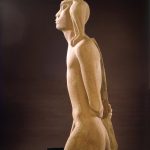
זהותה וצביונה של התרבות הישראלית עמדו לדיון למן הקמת המדינה, שנדמה כי לעולם לא פסק מלהתקיים. שאלת מערכת היחסים בין האוניברסלי ללוקאלי, בין התרבות המערבית לתרבות המקומית המתהווה וזהותה של האמנות הישראלית נדונו לעומק בשיח הישראלי. מאמר זה מבקש להראות שמזרח ומערב אינם קטבים מנוגדים, בוודאי לא כשאנו מביטים באמנות הקלאסית, וגם לא באמנות הישראלית.

Sigalit Landau is an international sculpture, video, installation, and performance artist, born in Jerusalem, and raised also in the USA and the UK. The infernal main space in her installation “The Dining Hall” (2007, KW Institute for Contemporary Art, Berlin) is filled with images resembling human remains engaged in riotous consumption from huge iron pots, in physical circus-like tricks, and copulation, surrounded by huge fleshy-like constructions. While the immediate association may be that of an apocalyptic catastrophe in relation to the Holocaust, the reference is multifaceted, as this study seeks to show.

המעשה האמנותי מתמיר את השיירים שנותרו בנפש ומאפשר להגיע לקתרזיס – היטהרות. באופן זה המטאפורה והריאליה, המשל והנמשל, חד הם: המעשה האמנותי מגיע מן השיירים, ובמובן מסויים מן הפחים, מפסולת הנפש.

This study stems from an exhibition presented in November 2018 at the Ilana Goor Museum in Old Jaffa entitled "Dionysian Life". This exhibition took on a unique significance in this museum, which is located in an ancient building in Old Jaffa facing the sea and is characterized by an abundance and sensuality that is Dionysian in nature
Nava Sevilla Sadeh, “Dionysian Life in a Bacchanalian Space: a Multifaceted Dialogue in Old Jaffa”, Academia Letters, article 347, May – 2021

נאוה סביליה שדה, ״על טבע היקום/על טבע הקיום", קטלוג התערוכה Green Scream, סיגלית לנדאו, גלריה הראל, יפו, 2020

קמתי בבוקר והחלטתי לנצל את היום השמשי והיפה ולצאת למכור קופידונים. נשארו לי שניים בכלוב, אחרי שמכרתי לפני הסגר שלושה, ואמרתי לעצמי שלא יקרה כלום אם אצא למכור כעת. אחרי הכל, קופידון תמיד היה מצרך מבוקש, אוכל לומר שאני עובדת חיונית, ואף שוטר לא יוכל לסתור זאת.
סיפור קצר מאת נאוה סביליה שדה

מה הקשר בין מרסל דושאן, ג׳וזף קוסות׳ וסול לוויט, לגנים של ליוויה ולציור כד יווני עתיק?
נאוה סביליה שדה, ״על מה יש לשבח את כתר הוורדים״, אלכסון, 7.3.21

“[…] נפש-האדם, שעליה אומרים שבגוף ימצאוה רעות ותלאות, כיוון שהיא שוקעת בדאגות, תאוות, פחדים ובשאר דברים רעים […] הגוף הוא עליה ככלא וכקבר, והעולם מערה ומחילה […]”
(פלוטינוס, אניאדה רביעית, 3, בתרגום נתן שפיגל)

אודות התערוכה Green Scream של סיגלית לנדאו, גלריה הראל, 2020.
מעצם העובדה שהתערוכה היא תגובה למגפה, מובן שיש לראות במבט ספקני את ההתרפקות על שיר ההלל לירוק של נתן זך כנקודת המוצא שלה. מאחורי התרפקות לכאורה זו עומד מבט ביקורתי, שבא לידי ביטוי בכל פרט בתערוכה.

פלורליזם כערך רעיוני ואסתטי מבצבץ מבעד למשטחים הרב שכבתיים והמרובדים בעבודות הצילום והקולאז' של פלדמן. עבודות מרובדות אלו נושאות משמעות ערכית, כאשר קדוּשה וחילוניות דרות בסמיכות במרחבים הגיאוגרפיים והכרונולוגיים ביצירתה.

The Roman mosaic known as the Asàrotos òikos ("the unswept floor") represents waste of food such as cherries, grapes, leaves, nut shells, lobster claws, fish skeletons, oysters, chicken bones, and even a tiny mouse. Another part of the mosaic features Dionysian tragic masks. This depiction seems to offer an integration between the abject and the divine, or the sacred and the profane. The question arises as to the meaning of this integration. The present study examines two dominant states suggested in this mosaic: decadence and hedonism. These states are anchored in both ancient and modern philosophical thought and poetic utterances. It seems that while decadence defines a social state, hedonism defines a religious spiritual state, and both states might be perceived as represented in this mosaic.
Nava Sevilla-Sadeh, "Decadence or Hedonism? The Abject as Sublime in the Asàrotos òikos Mosaic Floor from the Vatican ", Source: Notes in the History of Art, Vol. 38 Number 3, Spring 2020, pp. 140-149.
https://www.journals.uchicago.edu/toc/sou/2020/39/3

The wall paintings decorating the dining hall in the villa of Livia, Emperor Augustus' wife, depict an abundant orchard with many species of trees, flowers, and birds in a quiet and peaceful setting. Although the style is very naturalistic and mimetic, what one sees is a combination of plants and fruit trees not normally in season together, endowing this orchard with a paradisiacal nature. The picturesque naturalism of the depictions has led scholars to interpret it as a reflection of calm and peace in relation both to the atmosphere under the reign of Emperor Augustus, and to his rehabilitation of the Republic and the spirit of moral renewal he established. Thus, this paradisiacal orchard has been perceived as a reflection of the Augustan Golden Age, the peace achieved after a terrible war, and a return to the traditional values and morals. Indeed, Augustus could well be proud of his achievements. However, a question arises regarding the true nature of the peace and prosperity claimed by Augustus, since it is well attested by researchers of Roman history that hunger and war were still present in many parts of the empire. Augustus employed both economic and social manipulation in order to control the people, and his approach led to an escapist state of mind by the people, as reflected in the concept panem et circenses coined by Juvenal. Such escapism was typical to the Roman disposition and was further nurtured and intensified by the Roman emperors. The present study focuses on a prominent picturesque feature in Livia’s “garden” paintings – illusionism, which is manifested in several aspects. This visual illusionism suggests a reflection of a mental illusionism: namely, the illusory and delusive atmosphere and the escapist spirit generated by Emperor Augustus.
Nava Sevilla-Sadeh, "Escapism and the Sublime: The Meanings of Illusionism in Livia's Garden Paintings", Studies in Visual Arts and Communication V. 6 (2), 2019.
https://journalonarts.org/current-issue/

The Kouros image in Archaic Greek art has never been perceived as expressing emotions; and nor have his eyes been a focus of research. Rather, the gaze of most of the Kouroi has been perceived as reflecting a sort of denial or cancellation of expression and emotion. However, the opposite of emotion is in itself an emotion and, indeed, once a human figure is portrayed its expression always conveys some sort of emotional message, no matter how indifferent it may seem. Moreover, emotions in Ancient Greece were perceived differently from their conception today. The present study focuses on the meanings expressed by the gaze of the Kouros type, and examines the essence of this expression as it was understood by the beholder in Antiquity. Two kinds of gaze reflected from the eyes of Kouroi can be discerned: a seemingly hollow and emotionless gaze; and a glowing and radiant gaze. The argument presented here is that both these kinds of gaze are manifestations of eudaemonia – happiness as a reflection of social customs and religious practices.
Nava Sevilla-Sadeh, "Reflections: Eudaemonia in the Eyes of the Kouros", Akropolis: Journal of Hellenic Studies, vol. 3, 2019
http://helenskestudije.me/ojs/index.php/jhs/article/view/30

עיני הדמות המכונה "הרכב מדלפי", המשובצות אבני חן, מביטות לעבר האופק, והבעת הפנים בכללותה משדרת רוגע לכאורה. מבע זה אינו מסגיר כלל, למעשה, את החרדה הקיומית בה נתון הרכב. על אצילות רוחנית, עוצמה פיזית, ופגיעות אנושית.

יצירתה של בתיה שני מתמקדת בטקסטים הרקומים על מפות, ממחטות וכותנות ישנות. שני נעה בין תפיסה מעודנת ופואטית של דמות האישה כאלה וזיהויה עם מעשה הרקמה באופן המעלה בזיכרון הקשרים מיתולוגיים, לבין עיסוק בחיפצון האישה והיותה אובייקט לניצול.
המיתוס של פילומלה מהווה סיפור מסגרת לפרשנות יצירתה של שני כארכיטיפ למצב אופייני של נשים, אשר מסוגלת לשלוח חוטים בלבד על מנת להמחיש את שעברו. יצירתה של שני היא כמעין הרחבה של מילותיה של פילומלה, וכפי שאומרת באופן מטאפורי כותרת התערוכה – "ככל שיותיר לנו החוט".
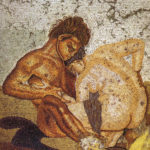
"פה נח קאיוס פומפיוס טרימלכיו, איש משוחרר של מצנאס. בהעדרו הוענק לו תואר של כוהן אוגוסטוס. הוא יכול היה להיות פקיד בכל משרד ברומא, אך סירב. ירא אלים, אמיץ, נאמן. הוא התחיל עם מעט מאוד כסף, והשאיר שלושים מיליון. לעולם לא הקשיב לפילוסוף. שלום עליך טרימלכיו, וגם עליך העובר ושב. לאחר שאמר זאת, החל טרימלכיו לשפוך מבול דמעות. גם פורטונאטה בכתה, ובכה האבינאס. אחר כך החלו העבדים לבכות, כאילו הוזמנו להלווייתו ומילאו את אולם האוכל בבכי. אפילו אני התחלתי לתת את קולי בבכי, כאשר טרימלכיו אמר: אכן, כשידוע לנו שאנו מוכרחים למות, למה שלא נחיה?[…]" ( סאטיריקון, 5.71-72)

המבקר הנכנס בשערי תערוכתה החדשה של דבורה מורג "מעשיה מקומית" המוצגת בחלל גלריית בית חנקין במושב כפר יהושע (אוצרות – נטע הבר ואיילת הרצוולף) עשוי לחוש כאילו הוא מהלך בשדרת דקלים, או לחילופין נכנס בשעריו של מקדש קטן. שדרת העצים/עמודים עשויה לאזכר שדרת עמודים מסביב לחדר הפנימי (naos) במקדש יווני עתיק, בו נשמר פסל האל.
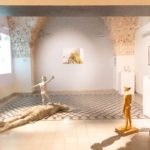
התערוכה "אתונה בתל אביב" באוצרותה של שירה פרידמן מבקשת לבחון קיום של קשרים בין מחשבה יהודית למחשבה הלניסטית, ומשמעותו של מיזוג זה בעידן הנוכחי, תוך שהיא מקיימת דיאלוג במספר רמות: בין המקרא למיתוס הקלאסי, בין היהדות לפאגניזם, ובין העולם העתיק לעידן העכשווי. ואכן, העבודות המוצגות אוצרות סוד ותכנים רבי משמעות. אבקש לנתח להלן תערוכה זו, תוך התמקדות בקשר בין העבודות והצבתן, ובאופן בו מתקיים דיאלוג ביניהן, אשר ממנו עולים מסרים אודות טיבה של חווית הנשגב בעולם העתיק בהשלכה לחוויה זו בעידן העכשווי.

"[…] ישנם עוד שני סוגים שמשתיירים באותה דרך עצמה, לאחר שכמות גדולה של מים הופרשה מתוך התערובת; אולם הם עשויים מחלקי אדמה עדינים יותר, וטעמם מלוח. הם אינם נקפאים אלא למחצה, ושוב נמסים במים. אחד מהם הוא נֶתֶר המנקה לכלוך של שמן ואדמה; השני הוא נוח להתערבב עם תבלים למיניהם; הלא הוא המלח; חומר שלפי אמונת בני האדם חביב הוא לאלים […]" (אפלטון, טימיאוס, בתרגום י.ג. ליבס, שורות 60-61)

Nava Sevilla Sadeh, "Is there any Such Thing as Classical Beauty? Greek Aesthetics as a Political Mechanism", The International Journal of Arts History and Theory 14 (1): 27-45 Abstract “Classical beauty” is a term commonly used to characterize a type of elegance and noble appearance that is not subject to trends. In contemporary art “beauty” can sound […]
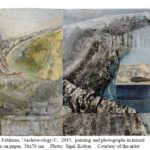
Nava Sevilla-Sadeh, "A Secular Holy Land: Pagan Images, Jewish Motifs and National Identity – Reflections on Dorit Feldman’s Artwork", Israel Affairs, V. 24, 2019, pp. 1-31 Abstract Dorit Feldman is a prolific Israeli artist who over the course of several decades has focused on images of wide landscapes that integrate geological, cartographical, and archeological […]

Nava Sevilla-Sadeh, “Who Are You, Beautiful Woman? The Mona Lisa from Sepphoris in the Light of Epicureanism and Neo-Platonism”, CLARA – Classical Art and Archeology, Vol. 3, 2018, pp. 1-24 Abstract The identification of the image known as the ‘Mona Lisa’ portrayed in the floor mosaic from the Roman Dionysian villa at Sepphoris has […]

Initiation or rites of passage in the ancient world constituted a highly meaningful experience and were intended to delineate the transition from childhood to adult status, with the sacred initiation meant to promise a merging with the divine.
Nava Sevilla-Sadeh, "Les Rites de Passage: Ritual, Initiation, and the State in Works by Sigalit Landau and Anisa Ashkar", Visual Resources, 34, pp. 1-25, 2018

Maenadism in Antiquity was a phenomenon both manifested in myth and experienced in the life of women, in rituals dedicated to Dionysus. The maenadic dance was of a violent nature, comprising repeated hysterical shaking of the head and body and loss of the senses.

As an artist distinctively identified with the currents of conceptual art, Raffi Lavie (1937-2007) was one of the most influential artists on the Israeli art scene during the 1970s and 80s, and also represented Israel at the 53rd Venice Biennale. Although much has been written on his artistic work, it has remained enigmatic, given that his signifiers are deliberately vague…

תופעת המאינדיזם (Maenadism) בעולם העתיק באה לידי ביטוי הן במיתוס והן בפולחן האל דיוניסוס. במחקר נעשתה הבחנה חשובה בין המאינדיזם במיתולוגיה לבין המאינדיזם כתופעה דתית-חברתית. התבוננות מזווית שונה ביצירתן של אמניות ישראליות עכשוויות מגלה מאפיינים חזותיים ורעיוניים של מאינדיזם, פולחן וחניכה.

“Herakles’ Intoxication in Mosaics from Israel: A Neoplatonic View”, Actas do X Coloquio Internacional da Associacao Internacional para o Estudo do Mosaico Antigo (AIEMA), Museo Monografico de Conimbriga (Portugal), 29 de Outubro a 3 de Novembro de 2005

The mythological couple Mars and Venus are represented in several sculptural images dated to the 2nd century CE. Some scholars contend that these images represent imperial couples seeking to imitate the divine couple Mars and Venus, with the intention of presenting the new imperial order as divinely sanctioned. Other scholars suggest that these images are not those of imperial figures but, rather, wealthy members of society who imitated the contemporary trend of adopting mythological portraiture, attired as mythological figures, as a customary practice amongst the imperial class…
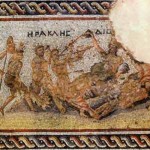
משתה חגיגי של האל דיוניסוס והגיבור הֵרַקלֵס הוא נושאו של הספין המרכזי ברצפת הפסיפס בווילה הרומית בציפורי. סצנה זו הוגדרה במחקר כתחרות שתייה בין האל לגיבור; בעיצומה של התחרות אל היין מניף את גביעו בתנועת ניצחון, וכך מתאפיין כבעל תבונה ושליטה עצמית ואילו הרקלס מתבזה בשתייה בלתי מרוסנת עד אבדן חושים, מה שלכאורה מאפיין אותו כחסר מידה, ולפיכך חסר שיקול דעת ולוקה בהיעדר שליטה עצמית.
// פורסם ב'קתדרה', גליון 127, 2008, עמ’ 6-32

Sigalit Landau is an international sculpture, video, installation, and performance artist, born in Jerusalem, and raised also in the USA and the UK. This study seeks to analyse Landau’s unique body representation of figures made of papier-mâché, focussing on the installation “The Country.” The point of departure of this study is a passage from the Platonic dialogue Timaeus, whose text strongly resembles Landau’s succulent human images composed of soft bones, moist flesh, and sinews. This analogy then leads to a wider comparative discussion on the meanings of the body in Archaic and Classical aesthetic concepts in comparison with its postmodern meanings
// Journal of Aesthetics & Culture, Vol. 7, 2015

The postmodern state of mind was defined by theorists such as Fredric Jameson as a-historical, and today’s society as “bereft of all historicity and denies its past which is modified into a vast collection of images and thus effaced altogether”. However, and from an approach contrasting a-historicism, the following study employs Classical Reception Studies as a comparative methodology in the analysis of contemporary art.
// Published in: International Journal of Art and Art History, 3(1), pp. 19-61

Yiqing Yin’s installation “In-Between” at the Venice biennale 2013 appeared in the center of the Venice pavilion space. This image, of enormous dimension, resembles a vision that recalls pagan epiphanies in mythology and art. The elegant elongated figure is linear in a way that calls to mind visual images from a more distant heritage. Moreover, metaphors of fabrics and threads, as well as mythical weavers, are very common in Greek mythology. The reference to the Classical heritage accords with the main curatorial concept of the whole exhibition titled, “the Encyclopedic Palace." The present research is comparative in nature, belonging to the realm of Reception Studies, and is based upon a premise according to which the knowledge of the past is relevant in its potential for contribution to the understanding of the present. This analysis of Yin’s installation in reference to Classical artistic comparisons and mythological literary metaphors reveals meanings pertaining to the social-gender and spiritual contexts, and aims to extend the implications of Yin’s work in accordance with the curatorial concept underlying the 55th biennale exhibition
\\ The International Journal of Arts, Theory and History, Volume 10, Issue 4, 2015

The motif of the abduction of a woman is one of the most frequent in Ancient Greek and Roman art. Abductions in mythology are generally portrayed as carried out by a god disguised as a human or an animal, such as Zeus who, in the form of a bull, golden rain or a swan, seduces a beautiful young maiden….
// Nava Sevilla Sadeh, "Divine Love: The Reception of Leda and the Swan Myth in Works by Jewish and Arab Israeli Artists – Contexts and Meanings", Journal of Arts and Humanities, V. 3 n. 8, August 2014

This research is specifically aimed at exploring the characteristics of the impact and acceptance of Classical art in contemporary art. The study focuses on two works exhibited at the Tel-Aviv Museum of Art in 2008 (in two separate exhibitions): The Unseen Venus by Lea Avita, and the installation SOMA by Ayala Serfaty.
Consciousness, Literature and the Arts, Volume 15 Number 1, April 2014

The artwork of Asad Azi, an Israeli-Druze artist, is deeply inspired by Classical images and subjects. As a socio-political artist, by using the classics Azi conveys subversive and critical messages.
In a series of works exhibited recently in an exhibition titled – Bacchanalia, hybrid creatures, Dionysian in character, fill Azi’s canvases. Hybrids such as centaurs and satyrs symbolized in Antiquity the opposition to the principles of moderation (aidos), self-knowledge (sophrosyne), and self-control (enkrateia) to which the Greek citizen was obliged, and were thus connected with Otherness. Metaphorically, hybridity in Azi’s work symbolizes socio-political Otherness and its implications in connection with post-colonial theories. An additional and very prominent aspect of the hybrid in Antiquity was their role as intermediaries between the human and the divine, as noted by Friedrich Nietzsche in his reference to the Dionysian mystic initiation. This aspect sheds another light on the hybrid images depicted by Azi, and the meaning of the Other and the minority in modern times. The present study is interdisciplinary in nature and belongs to the field of reception studies, and aims at examining the Classical influence upon contemporary culture.
// Journal of Arts and Humanities, Vol 2, No7, August 2013

ניצחונות צבאיים שהושגו על ידי גברים באתונה של המאה החמישית לפנה"ס זכו לייצוג נשי בדימוייה האמנותיים של ניקה, אלת הניצחון. הנחת היסוד של מחקר זה הינה, שדימויים אלו עיגנו מספר רמות של משמעויות מטאפוריות. מחד, קשורים הם להיבטים החברתיים, בעודם משקפים את התפיסות המגדריות האופייניות לעולם הקלאסי תוך שימוש במין הנשי בכדי לרומם את הגברי; מאידך משקפים הם היבטים רוחניים ואת תפיסות ה'יפה' והנשגב, הנטועים עמוק במחשבה הפילוסופית הקלאסית.
// פורסם ב'היסטוריה ותיאוריה: הפרוטוקולים', כתב העת של בצלאל, גליון 10, 2008
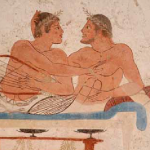
במרכזו של דיון זה עומדת ההנחה, כי השוואה והנגדה בין התרבות העתיקה לתרבות העכשווית עשויה להאיר ולחדד משמעויות ותובנות, כשם שהיפוך הסדר וההגיון בציור הסוריאליסטי למשל, משקף ומלמד דווקא אודות העולם הריאלי. להלן יידונו יצירות מן העולם הקלאסי ומספר יצירות מייצגות מהאמנות הישראלית העכשווית, במטרה לבחון את טיבם של קווים משותפים אלו ואת התפישות העומדות מאחורי הדימויים.
// פורסם ב'מותר' – כתב העת של הפקולטה לאמנויות באוניברסיטת תל-אביב, גליון 18, 2011, עמ’ 79-88
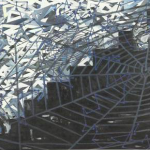
ביצירתה של האמנית דגנית ברסט הקשרים לתרבות הקלאסית, שבאה לידי ביטוי באימוץ מיתוס איקרוס ובסידרת צילומים של פסלים קלאסיים שבורים (הנחת היסוד למחקר זה הינה, כי ההקשרים הקלאסיים ביצירתה של ברסט הינם ענפים ועמוקים יותר מן ההיבט המיתולוגי והחזותי, וכי פרשנות השוואתית ביחס ליצירות מן העולם הקלאסי ומקורות ספרותיים ופילוסופיים עתיקים עשויה להרחיב את הדיון ולגלות משמעויות נוספות.
// פורסם בהיסטוריה ותיאוריה: הפרוטוקולים – כתב העת של בצלאל, גליון 23, 2012

The figurative scenes depicted in the mosaic floor from Sheikh Zouede have been interpreted as an expression of the Classical notion of the consequences of immoderation. This study sets out to show that whereas the erotic madness of Phaedra is a negative state, the Dionysian inebriation of Herakles is positive. The hero, rather than an uncontrolled drunken madman, is in fact consecrated through the Dionysian mysteries to Dionysus. The supremacy of that god reflects the increasing tendency toward monotheism in Late Antiquity. This reading is supported by an examination of Classical literary sources as the concepts behind these depictions…
// Sevilla-Sadeh, N. (2011), Telete and Eros: Meanings and Sources of the Mythological Scenes in the Mosaic from Sheikh Zouede, in Assaph, Studies in Art History, The Beauty of Japheth in the Tents of Shem, Studies in Honor of Mordechai Omer, Eds. Hana Taragan and Nissim Gal, Tel Aviv, Vol 13-14,159-172.

The mosaic floor found in a house at Bet-Shean was commissioned by a Jewish man named Kyrios Leontis Kloubas into three panels: the upper panel depicts the scene of Odysseus and the sirens, the middle panel contains an inscription, and the lower panel portrays a Nilotic scene. In the Homeric scene of Odysseus and the sirens, Odysseus appears twice – attached to the ship’s mast in the upper part of the panel; and on his ship, struggling with a sea monster. Between the two scenes an inscription reads: “God help Leontis Kloubas”. The middle panel features a medallion surrounded by birds. The inscription in the medallion states: “Be remembered for good and for praise Kyrios Leontis Kloubas because he paved this mosaic at his own (expense) for his own salvation and that of his brother Jonathan”. presents a Nilotic scene with a personification of the Nile sitting on a crocodile. To its side is a nilometer – a device designed to measure the water level for the overflow of the Nile – and a building with a tower and upon it the inscription – “Alexandria”. The bottom panel features a ship with a single human figure, set on the sea.
// Sevilla-Sadeh, N. (2006), A Promise of Wisdom: The Classical Origins of the Odysseus and the Sirens Mosaic Floor from Scythopolis (Bet-Shean). In Verzar, C. and Fishhof, G. (Eds.), Pictorial Languages and their Meanings – Liber Amicorum in Honor of Nurith Kenaan-Kedar, Tel-Aviv: Tel-Aviv University, the Yolanda and David Katz Faculty of the Arts, 203- 220.

Sevilla-Sadeh, N. (2005-2006), "A Hero in a Girl’s Dress: The Meaning of Achilles’ Image and Marginal Decoration in a Mosaic from Shechem-Nablus". In Mucznik, S. (Ed.), kalathos – Assaph, Studies in Art History, 10-11, pp. 431-450
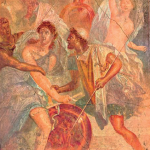
מפגש חניכה וטקס מעבר, מפגש פרֵדה בין רעיה לחייל היוצא לשדה הקרב, מפגש בין אדם ליצורים שהם ספק–חיה ספק–אישה, מפגש והתמזגות של האדם והאל — אלה הם כמה מן האירועים הדרמטיים המתוארים בספרות היוונית ומוצגים בציורי כדים ובפסיפסים ששרדו מן התרבות הקלסית. מפגשים אלה מבטאים את מנעד הרגשות, השאיפות והתשוקות שייחסו בעולם העתיק לגברים ולנשים, לבני–אנוש ולבני אלים. נאוה סביליה שדה בוחנת כמה דוגמאות של ייצוג מפגשים כאלה ומסבירה את משמעותם לבני תקופתם.
//פורסם ב'זמנים: רבעון להסטוריה', גליון 100, 2008, עמ' 18-27

שימוש בחומרים שונים ומשונים כבר אינו מפתיע איש בזירת האמנות העכשווית. עם זאת נדמה, שבתערוכה הנוכחית שמורה משמעות מיוחדת להשפעת החומר על הצופה בשל הפעלת חושי הטעם, הריח וכמובן הראייה, הגוררת מעורבות קיצונית (אכילה, אטימת נחיריים, התבוננות משועשעת וכדומה). העיסוק בכיליון ובבזות (abject) שב וחוזר באמנות העכשווית, אולם עתה זוכות סוגיות אלו למעין "תחייה" באמצעות הלבשתן בלבוש מיתולוגי ובאסתטיקה פסוודו־ קלאסית. לעיסתו של פסל כמו־קלאסי והעובדה שהוא מדיף ריח עז, מהוות מטאפורה רטורית לתפישת הקלאסיקה כלעוסה וכעבשה. ובכל זאת, האם ניתן למצוא משמעות חדשה ומרעננת לפסל בסגנון קלאסי בתערוכה המוצבת בחלל תצוגה עכשווי בעל אופי תעשייתי, ומבוססת, רובה ככולה, על קריצה אל הקלאסיקה?
// פורסם בכתב העת טרמינל, גליון מס' 50, ספטמבר 2013

"נסיונות להסוואה, שקיפות, כסות והסתרה הם מוטיבים משותפים בתרבות היפנית והקלאסית, והם מתנקזים אל בדיה של אילת זהר, אמנית ישראלית. הדבר מחזיר את הדיון לתחילתו: הפסטורליה נגמרת כאשר אנו מבחינים בצלפים המוסווים בתוך גן העדן". נאוה סביליה שדה בעקבות התערוכה "שקוף למשתמש" של אילת זהר, גלריה מינוס 1, תל-אביב

ראש פיסולי מעוטר בכתר זהב מלכותי מושך את עין הצופה, וגורם לתהות – האמנם פסל הוא זה, או בן אנוש? נדמה כי זוהי מלכה רמת מעלה השרועה בארון קבורה, כאשר שלוות מוות נסוכה על פניה. עיניה עצומות והגבות מקושתות מעליהן; מגע של אודם משוך על השפתיים, תלתלים בהירים חושפים עדיי עגילים המעטרים את תנוכי האוזניים, כאילו שרד הגינדור את המוות, קורץ בחציפות ושופע חיים. המבט הנופל אל סיומת הצווארון הוורדרד המתמזגת עם הרקע הורוד הכהה יותר, נוסך תחושה קשה ואף מין פליאה: האם ראש כרות הוא זה? ואולי זהו בעצם ראש המוטה לאחור בעונג של אקסטזה אלוהית?
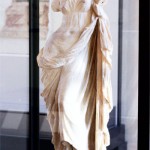
לעיתים קרובות אנו משתמשים במושג 'יופי קלאסי' בכדי לאפיין מראה הנתפס בעיננו כמופתי. מהו טיבו של 'היופי הקלאסי'? מהו אותו מופת המענג את עיננו? האם בכלל קיים מופת אסתטי אליו יש לשאוף? מאמר זה ידון באחד ההיבטים של שאלה זו, ובכדי להשיב עליה, יש ראשית כל, לשוב למקום בו נולד המושג – יוון הקלאסית.
// פורסם ב'עיצוב תדמית', האתר האלקטרוני לתדמית ושפת הגוף

במיצב הווידיאו של האמנית עדן אורבך-עפרת, הפכה רצפתה של גלריית האוסף במוזיאון פתח-תקווה לגדת נהר השכחה (נהר הלֶתה, Lethe), אחד מחמשת נהרות השאול במיתולוגיה היוונית. צרור קטן ומאוגד של פסלים וציורים מאוסף המוזיאון ניצב על מצע של חול ים ממשי, ממתין לנטילתו בידי כארון (Charon), האל המעביר את נשמות המתים. דמותו בסרט משיטה את צרור היצירות הסמלי בסירת משוטים רעועה, שמעידה אולי על הוותק הרב שצבר בעיסוקו זה.

"מחול המוות" (Dance Macabre), כותרת התערוכה בגלריה בנימין (אוצר: ד"ר ערן גילת), הוא מושג השאול מאמנות שלהי ימי הביניים. הוא נקשר בעיקר עם המגפה השחורה, שבעקבותיה המוות שרה בכל. באמנות התקופה מתוארים שלדים המזמינים למחול ורוקדים בעליצות מסביב לכל בן-אנוש אפשרי. דימויים אלה נועדו לסמל את היותו של המוות משותף לכל, לעני ולעשיר, למלך ולאיכר. נושא זה זכה לביטויים רבים לאינספור באמנות ובספרות, ונבע מתוך החרדה הקיומית המשותפת לכל חי באשר הוא.
//פורסם ב"ערב רב" // "להמתיק את מר המוות", מאמר בעקבות שיח גלריה בתערוכה "מחול המוות" בגלריה בנימין, ינואר 2014 \\ אמנים: סיגלית לנדאו, ערן גילת, מירה מיילור, שירלי פקטור, רני פרדס \\ אוצר: ד"ר ערן גילת